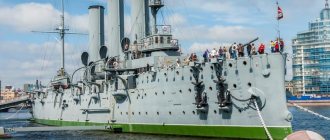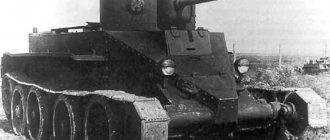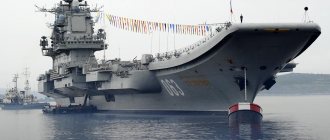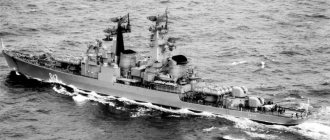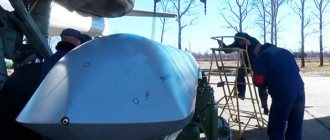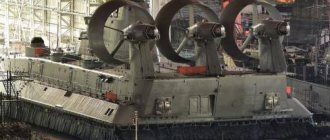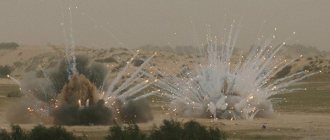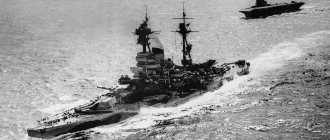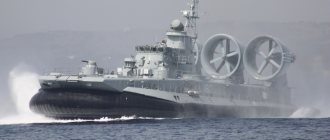Soviet rocket depth charge RSL-60 Destruction of submarines is a rather difficult task, for which special means must be used. For a long time, the only weapons capable of hitting submarines were depth charges. From a modern point of view, they do not have the necessary accuracy and efficiency, but their low cost and simplicity of design made it possible to use them in large quantities, which to some extent compensated for the shortcomings. Today, modern depth charges are still in service with the navy, although their functions have changed somewhat - they are now intended primarily to intercept attacking torpedoes or destroy combat swimmers.
History of the creation of the depth charge
For a long time, submarines, the first examples of which appeared at the end of the 18th century, posed the greatest danger to their own crew, and not to the enemy. For this reason, until the First World War, there were no means of combating them.
In 1913, the so-called “dumpable charge” was developed in Great Britain. It was intended to destroy underwater mines laid by the enemy. It was an ordinary barrel of explosives, which was supposed to be dropped from the carrier ship. The main technical innovation was a hydrostatic fuse, triggered by water pressure after reaching a certain depth (about 30 meters). This weapon received the original name “cruising mine” or “deep mine”.
Weighing more than 500 kilograms, the discharged charge could damage the carrier ship itself during the explosion, since the distance to the point of its fall into the water did not exceed fourteen meters. Thus, this weapon was not suitable for mine clearance, but it served as a prototype for the future depth charge.
The first British Depth Type D depth charges are fired from launchers.
Ammunition was developed in 1916, and installations only in the 30s. When the war began in 1914, for some time they tried to use special artillery shells to destroy submarines. They were made in such a way as not to ricochet off the surface of the water and not explode prematurely. When a periscope was detected, the cannon opened fire in the direction of the submarine, in the hope that the shells, while diving, would be able to hit it with a direct hit. Of course, such a method could only work under a very successful set of circumstances (however, already during the Civil War, the Soviet destroyer Azard managed to destroy an English submarine in exactly this way - from a gun).
Full-fledged depth charges did not appear until January 1916, when Herbert Taylor managed to improve the hydrostatic “drop-charge” fuse. The size and weight of the new ammunition were no longer as great as that of the prototype. The D-type depth charge had a warhead mass of 140 kg (300 lb), and the D* type had a warhead weight of 54 kg. It was assumed that the lighter version would be used from slow-moving ships.
The fuse could be installed in one of two positions - for detonation at a depth of 12 or 24 meters.
The first submarine destroyed by a depth charge was the German submarine U-68. This happened on March 22, 1916 and led to an increase in the production of new weapons. By the end of the war, some British ships already carried 30 or even 50 depth charges.
The first Soviet depth charge BB-1
It is curious that the Soviet television film “Captain Nemo” demonstrates an attempt to destroy the famous “Nautilus” using depth charges - and this despite the fact that the action of the novel “20 thousand Leagues Under the Sea” takes place in the 60s years of the 19th century. Of course, this episode is a figment of the writer’s imagination - nothing like this simply could have happened in those ancient times.
Rising from the depths
Engine driver Walter Schmitenknop was one of the last who was still holding on, gasping for air near the ceiling with his lips. When he looked at the hatch, he noticed that water was coming through it. This means that once the compartment is flooded, the pressure has equalized and the hatch can be opened!
Walter Schmitenknop
Shmitenknop quickly put on his breathing apparatus and opened the hatch.
It is interesting that Shmitenknop did not suffer barotrauma of the lungs and was not injured by the caisson. But the boat did not let him go without injury. While passing through the hatch, his hands were injured.
The mechanic took his salvation as a miracle. And soon another thing happened - a German was spotted on the destroyer and brought on board. Now Walter had no doubt that his life was in the hands of God. He promised himself to be ordained when the war was over.
The submariner remained in captivity until 1947, after which he was repatriated to Germany. Four years later, Shmitenknop emigrated to Canada.
Development of deep weapons
After the end of the First World War, depth charges improved markedly - their maximum immersion depth increased, and additional types of fuses were developed. In addition, already in 1930, they began to develop a special device for the British Royal Navy, called the Hedgehog. It was a bomb launcher with which an anti-submarine ship could attack submarines ahead of them, potentially increasing the likelihood of hitting a target.
Due to lack of funding, the creation of “Hedgehog” was delayed almost until 1940. Similar problems were observed in the USSR, where the first samples of their own depth charges had already been created, but for a long time it was not possible to ensure a sufficiently reliable operation of their fuses. In addition, Soviet models were equipped with ordinary TNT, while in the UK and the USA, high-power explosive compounds were developed for these ammunition - minol and torpex.
The primitive cylindrical shape of the first depth charges reduced their sinking speed. In addition, they could, for example, get caught in the wake and deviate from the given direction. To eliminate these shortcomings, in 1940, the UK developed drop-shaped bombs with stabilizers - Mk.9. True, it entered service only in the spring of 1943.
Spherocylindrical depth charge Mk.9 (UK)
During the war, the Soviet fleet widely used anti-submarine weapons supplied under Lend-Lease. These included bomb throwers of various types (including Hedgehog), sonars, and depth charges themselves. All this technique was then used to create our own samples.
The next step towards the development of anti-submarine weapons was the appearance of jet depth charges. Their first samples were developed by American engineers in 1942. The new ammunition was intended for the Mousetrap bomb launcher, which was originally a variant of the British Hedgehog. Replacing the expelling powder charge with an active-jet engine made it possible to significantly increase the radius of the installation and increase the speed of the bomb’s entry into the water.
In the post-war years, rocket launchers also appeared in service with the Soviet Navy. The first of them was RBU, created in 1945, and one of the most advanced was RBU-6000. Such installations were available on board all anti-submarine combat ships, which allowed them to destroy submerged submarines at a distance of up to six kilometers.
As much more accurate and long-range anti-submarine weapons later became available, the purpose of depth charges has changed over the years. Modern warships use them to protect themselves from torpedoes. In particular, the RBU-12000 (“Boa Constrictor”) bomb launcher ensures the interception of these weapons with a probability of up to 90%. Of course, if the enemy submarine hesitates and comes too close, then it can also be attacked with bombs.
RBU-6000 rocket launcher
Aviation torpedo release systems
The main problem when dropping torpedoes from the air was the need to perform this operation at minimum speed, extremely low altitude (3-6 meters) and at a distance of 1400-1800 m from the target, which made the torpedo bomber aircraft extremely vulnerable. The first successful torpedo drop from an aircraft was carried out on July 28, 1914 from a Calshot seaplane. A year later, seaplanes launched from the seaplane HMS Ben-my-Chree sank 3 Turkish ships in the Dardanelles. In the early 1920s, retired Australian Air Force Lieutenant Frederick Bernard Fowler founded the Eastbourne Aviation
, which received a contract to train pilots of carrier-based aircraft of the Imperial Japanese Navy. The training groups included both fighter pilots and torpedo bomber pilots. The Japanese quickly came to the conclusion that specially designed aircraft should be used as torpedo bombers, rather than adapting fighters and bombers for this purpose. Torpedoes were also modified for the release, which made it possible to create the best combination of the Nakajima B5n torpedo bomber and the Type 91 aircraft torpedo during the Second World War. The release of torpedoes was possible at speeds of up to 300 km/h (later up to 560 km/h) from an altitude of up to 60 m, which significantly exceeded the similar indicators of torpedo bombers from other countries.
Operating principle and design features
As you know, water is practically incompressible. This property can be used to destroy both conventional ships and submarines - the water hammer created by an underwater explosion is capable of breaking through even the most durable hull. Thus, to destroy a submarine it is not at all necessary to hit its hull directly; it is enough to ensure detonation at a certain distance to the target.
The design of a depth charge is not very complicated. Each of them is a container with relatively thin metal walls, filled with an explosive. Initially, such ammunition was very similar to ordinary barrels. Then, in order to increase the speed of immersion and make it more orderly, the bombs began to be equipped with stabilizers, and their shape became teardrop-shaped (spherocylindrical).
The detonation is carried out at a depth, the value of which is established before dropping or launching the bomb. Initiation is ensured by the increase in water pressure as you dive. In this case, along with hydrostatic fuses, the following types of additional fuses are used:
- Contact. Works upon direct impact with the target;
- Magnetic. Reacts to the magnetic field created by the submarine's hull;
- Acoustic. Picks up the noise created by the submarine's propellers and detonates the charge.
The bombs used on the Hedgehog and other bomb launchers of World War II had an additional propellant charge. In their design they resembled mortar shells.
Loaded Hedgehog Bomb Launcher
Modern jet depth charges have the greatest complexity of the device - part of them is an engine that provides a significant flight range.
How does a nuclear submarine work?
Date Category: Transportation
Nuclear submarines and other nuclear-powered ships use radioactive fuel—mostly uranium—to turn water into steam. The resulting steam rotates turbogenerators, which produce electricity to propel the ship and power various onboard equipment.
Radioactive materials like uranium release thermal energy through the process of nuclear decay, when the unstable nucleus of an atom is split into two parts. This releases a huge amount of energy. On a nuclear submarine, this process is carried out in a thick-walled reactor, which is continuously cooled with running water to avoid overheating or even melting of the walls. Nuclear fuel is particularly popular with the military on submarines and aircraft carriers due to its extraordinary efficiency. On one piece of uranium the size of a golf ball, a submarine could circle the globe seven times. However, nuclear energy poses dangers not only to the crew, who could be harmed if a radioactive release occurs on board. This energy poses a potential threat to all life in the sea, which could be poisoned by radioactive waste.
Schematic diagram of the engine compartment with a nuclear reactor
In a typical nuclear reactor engine (left), cooled water is pressurized into the reactor vessel containing nuclear fuel. The heated water leaves the reactor and is used to turn other water into steam, and then, when cooled, is returned to the reactor. Steam rotates the blades of a turbine engine. The gearbox converts the rapid rotation of the turbine shaft into a slower rotation of the electric motor shaft. The electric motor shaft is connected to the propeller shaft using a clutch mechanism. In addition to transmitting rotation to the propeller shaft, the electric motor generates electricity, which is stored in on-board batteries.
Nuclear reaction
In the reactor cavity, the atomic nucleus, consisting of protons and neutrons, is struck by a free neutron (figure below). The impact splits the nucleus, and in this case, in particular, neutrons are released, which bombard other atoms. This is how a chain reaction of nuclear fission occurs. This releases a huge amount of thermal energy, that is, heat.
A nuclear submarine cruises along the coast in a surface position. Such ships need to replenish fuel only once every two to three years.
The control group in the conning tower monitors the adjacent water area through a periscope. Radar, sonar, radio communications and cameras with scanning systems also assist in the navigation of this vessel.
Characteristics of depth charges
The table shows the parameters of the most famous ammunition used to combat submarines:
| Name | BB-1 | Mk.6 (USA) | MkVII (England) | RSL-60 (USSR) |
| Weight | 165 kg | 191 kg | 185 kg | 119.5 kg |
| Depth limit | 100 m | 183 m | 305 m | Up to 450 m |
| Dive speed | 2.1-2.3 m/s | 3.7 m/s | Up to 3 m/s | 11.6 m/s |
| Damage radius | About 5m | 6.4 m | 6.1 m | No data |
| Type of explosive | TNT | TNT | Minol | TNT |
The first three types of depth charges were created in the 30-40s of the last century, the rocket RSL-60 - in the 50s. As you can see, the USSR initially lagged behind its allies in the anti-Hitler coalition in terms of the quality of ammunition, which explains the use of anti-submarine weapons received under Lend-Lease.
Properties of water
Underwater explosions differ from explosions in the air due to the properties of water:
- Mass and incompressibility (all explosions)
- water has a much higher density than air, which makes it more difficult for water to move (higher inertia). It is also relatively difficult to compress (increase density) under pressure in the low range, say up to 100 atmospheres. Together, these two factors make water an excellent conductor of shock waves from an explosion. - Effect of neutron irradiation on salt water (nuclear explosions only)
- Most underwater explosion scenarios occur in seawater, rather than fresh or clean water. Water itself is not much affected by neutrons, but salt is strongly affected. When exposed to neutron radiation during the microsecond of active detonation of a nuclear pit, the water itself is usually not “activated” and does not become radioactive. Two elements in water, hydrogen and oxygen, can absorb an additional neutron, becoming deuterium and oxygen-17, respectively, both of which are stable isotopes. Even oxygen-18 is stable. Radioactive atoms can arise if a hydrogen atom absorbs two neutrons, an oxygen atom absorbs three neutrons, or oxygen-16 undergoes a high-energy neutron reaction (np) to form the short-lived nitrogen-16. In any typical scenario, the likelihood of such multiple captures of significant quantities within a short time of active nuclear reactions around the bomb is very small. They are somewhat larger when the water is continuously irradiated, as in a closed-cycle nuclear reactor.
However, salt in seawater easily absorbs neutrons from sodium-23 and chlorine-35 atoms, which become radioactive isotopes. Sodium-24 has a half-life of about 15 hours, while chlorine-36 (which has a lower activation cross-section) is 300,000 years. After an explosion, the most dangerous contaminant is sodium because it has a short half-life. Typically, these are the main radioactive contaminants in an underwater explosion; others are the usual mixture of irradiated minerals, coral, unused nuclear fuel, and bomb casing components present as a result of surface detonation nuclear fallout, carried in suspension or dissolved in water. Conventional distillation or evaporation of water (clouds, humidity and precipitation) removes radiation contamination, leaving behind radioactive salts.
Atomic depth charge Mk.90 Betty (USA)
The emergence of nuclear weapons forced the command of the American navy to think about the prospects of their use against submarines. The first experience of this kind was obtained in 1946 during Operation Crossroads, when two atomic bombs were detonated for test purposes over the lagoon of the Pacific Bikini Atoll. Surface ships were considered the main target, but submarines were also hit.
The task of creating a nuclear depth bomb was set only in 1952. Three years later, it was possible to create an atomic weapon of the required dimensions. Its power was 32 kilotons. The test explosion was carried out on May 14, 1955 in the Pacific Ocean, at a depth of more than 600 meters.
Water plume created by the explosion of an atomic charge for the Betty depth charge
The results obtained were considered satisfactory, and within a few months mass production of an atomic depth charge began, designated Mk.90 Betty. Its mass was 1.12 tons with a length of more than three meters. It was assumed that aircraft would be able to attack submarines with the help of new weapons - dropping such a powerful warhead even from the fastest ship would simply be suicide.
The Betty carriers were Grumman S2F-2 Tracker carrier-based bombers. The “atomic” version of this aircraft had slightly increased dimensions due to the elongated bomb bay. In general, the Mk.90 was not very popular with military sailors and pilots due to its excessively strong charge and significant dimensions. Therefore, starting in 1958, it was gradually replaced by the more advanced Mk.101 Lulu.
In the early 90s, atomic depth charges were largely withdrawn from service. They were replaced by more accurate and easy-to-use anti-submarine weapons.
Video
Experienced bartenders claim that the Depth Bomb cocktail explodes three times: first in the glass during preparation, then in the mouth during tasting, and finally, after some delay, in the skull.
We will look at the classic recipe and two of the most popular variations of the drink. Historical reference.
It is unknown who first thought of putting a glass of strong alcohol into a glass of beer. In North America, these cocktails (in addition to the “Depth Bomb”, the names “Bomb shot” and “Boilermarker” are found) have been mentioned in printed publications since the 30s of the 20th century. According to one version, the name appeared due to the rapid intoxicating effect that causes an explosion in the depths of consciousness.
Use of depth charges in World War II
The largest number of attacks carried out by British and American warships against German and Japanese submarines during the Second World War were carried out the “old fashioned way” - by dropping several series of conventional depth charges astern. The use of more advanced means, such as the Hedgehog, became most widespread starting in 1943-44, when the battle at sea was already essentially won.
Attack of a German submarine using depth charges
Depth charges of the Second World War were dropped using special devices, and not singly, but in whole series of 3-7 pieces each. Soon, however, it turned out that this was far from enough, and already in 1942 the number of bombs in one series increased to 10-14 pieces. The British believed that a dozen Mk.VIIs were quite enough to destroy any German submarine.
The main problem was that the primitive sonars of those years did not allow us to accurately determine the depth of the target. Therefore, it was necessary to install the fuses in different ways, creating a kind of artillery “fork.” Bombs received under Lend-Lease were often not reliable enough and did not work. There have also been cases of individual ammunition colliding with each other, resulting in premature detonation.
There are no exact statistics that would characterize the effectiveness of the combat use of depth charges. The fact is that the cause of the death of a particular submarine is often disputed. In some cases, boats were destroyed by just one or two bombs, but there are also examples to the contrary. So, on May 5, 1943, the American destroyer Hesperus made several attacks on the German submarine U-223, dropping three series of seven bombs each, and then a large bomb weighing a ton.
Due to the damage received, the submarine was forced to surface, after which it was hit by another series of bombs set at a minimum depth. Hesperus then fired at U-223 with a 120 mm gun and the ship's Oerlikon machine gun, scoring repeated hits. Considering the target destroyed, the American destroyer left, but the German sailors managed to somehow repair their submarine and return to Saint-Nazaire.
Damage to the hull of the submarine U-534 caused by nearby depth charge explosions
Much more numerous were examples of attacks with an uncertain result - bombs were dropped, contact with the target was lost, and what happened to it was unknown. Even the appearance of debris or an oil slick on the surface of the water did not mean that the enemy had been destroyed. Nevertheless, we can say that the depth charges still fulfilled their purpose - after all, it was with their help that the “wolf packs” were driven under water over and over again, preventing them from launching an attack on transport ships.
The Japanese convoy went to sea
At the end of November 1943, American intelligence established that an important enemy convoy had departed from a Japanese base on the island of Palau. He was heading to their base - Rabaul. The ships carried ammunition, fuel and reinforcements to the Japanese garrisons. The detachment left Palau on the morning of November 25 and consisted of five ships guarding two anti-submarine ships.
USS Raton
The Americans had four Gateau-class submarines in this area." Newcomers who have not yet been in battle, Ray and Raton, and veterans, Pito and Gato, who have already opened an account of sunk Japanese ships.
Having received a message from commander Raton, Gato and Rei joined in the pursuit of the Japanese. Before the attack began, the submarines met at sea. Their commanders, using megaphones, agreed on a joint attack.
Effects
The effects of an underwater explosion depend on several factors, including the distance to the explosion, the energy of the explosion, the depth of the explosion, and the depth of the water.
Underwater explosions are classified by the depth of the explosion. Shallow underwater explosions are explosions in which a crater is formed on the surface of the water that is greater than the depth of the explosion. Deep underwater explosions are explosions in which the crater is small compared to the depth of the explosion or is absent altogether.
The overall effect of an underwater explosion depends on the depth, size and nature of the explosive charge, as well as the presence, composition and distance to reflective surfaces such as the seabed, surface, thermoclines, etc. This phenomenon is widely used in anti-ship warheads. structure, since an underwater explosion (especially an explosion under the hull) can cause more damage than a surface explosion of the same size. The initial damage to the target will be dealt by the first shock wave; this damage will be amplified by subsequent physical movement of the water and repeated secondary shock waves or bubble pulses. In addition, detonation of the charge away from the target can damage a larger area of the housing.
Underwater nuclear testing near the surface could disperse radioactive water and steam over a wide area, with serious impacts on marine life, nearby infrastructure and people. The underwater detonation of a nuclear weapon was prohibited by the Partial Nuclear Test Ban Treaty of 1963 and also prohibited by the Comprehensive Nuclear Test Ban Treaty of 1996.
Deep nuclear explosion
If an underwater nuclear explosion does not rupture the surface of the water in the form of a bubble of hot gas, it will leave no trace on the surface other than hot radioactive water rising from below. This always occurs with explosions at depths greater than 2,000 feet (610 m).
About a second after such an explosion, the hot gas bubble collapses because:
- The water pressure is enormous below 2,000 feet (610 m).
- Expansion reduces gas pressure, which lowers temperature.
- The Rayleigh-Taylor instability at the gas/water interface causes "fingers" of water to spread into the bubble, increasing the surface area of the interface.
- Water is almost incompressible.
- A huge amount of energy is absorbed by the phase transition (water becomes steam at the edge of the fireball).
- The expansion quickly becomes unstable because the amount of water pushed out increases with the cube
of the radius of the bubble explosion.
Because water is difficult to compress, moving so much of it so quickly absorbs a huge amount of energy - all due to the pressure inside the expanding bubble. The pressure of the water outside the bubble soon causes it to collapse back into a small sphere and bounce back, expanding again. This is repeated several times, but each bounce contains only about 40% of the energy of the previous cycle.
At the maximum diameter of the first oscillation, a very large nuclear bomb detonated in very deep water creates a bubble about half a mile (800 m) wide in about one second and then contracts, also taking about a second. Bubbles from deep nuclear explosions oscillate slightly longer than shallow ones. They stop oscillating and become hot water in about six seconds. This occurs earlier in nuclear explosions than in bubbles from conventional explosives.
The water pressure during a deep explosion prevents the bubbles from surviving and rising to the surface.
The dramatic 60% energy loss between oscillation cycles is caused in part by the extreme force of the nuclear explosion pushing the bubble wall outward supersonic (faster than the speed of sound in salt water). This causes Rayleigh–Taylor instability. That is, the smooth wall of water touching the surface of the explosion becomes turbulent and fractal, fingers and branches of cold ocean water go into the bubble. This cold water cools the hot gas inside and causes it to condense. The bubble becomes smaller than a sphere and more like the Crab Nebula, whose deviation from a smooth surface is also associated with the Rayleigh–Taylor instability, when ejected stellar material is pushed through the interstellar medium.
As you would expect, large shallow explosions expand faster than deep small ones.
Despite direct contact with a nuclear explosion, the water in the expanding bubble wall does not boil; the pressure inside the bubble exceeds (much) the pressure of water vapor. Water touching the jet can only boil while the bubble is compressed. This boiling-like evaporation, cooling the bubble wall, is another reason why the oscillating explosive bubble loses much of the energy it had in the previous cycle.
During these oscillations of hot gas, the bubble continually rises for the same reason as a mushroom cloud: it is less dense. This results in the explosion bubble never being perfectly spherical. Instead, the bottom of the bubble is flatter, and during compression it even tends to "pull up" towards the center of the explosion.
In the final cycle of expansion, the bottom of the bubble touches the top before the sides collapse completely, and the bubble becomes a torus in the last second of its life. About six seconds after the explosion, all that was left of the large, deep nuclear explosion was a column of hot water rising and cooling in the nearly freezing ocean.

